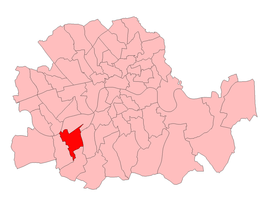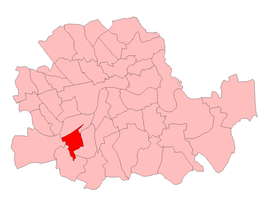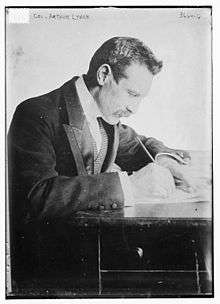Battersea South (UK Parliament constituency)
| Battersea South | |
|---|---|
|
Former Borough constituency for the House of Commons | |
| County | County of London, then Greater London |
| 1918–1983 | |
| Number of members | One |
| Replaced by | Battersea, and Tooting |
| Created from | Battersea |
Battersea South was a parliamentary constituency, originally in the County of London and later in Greater London. It returned one Member of Parliament (MP) to the House of Commons of the Parliament of the United Kingdom, elected by the first-past-the-post voting system.
It was created for the 1918 general election, when the former Battersea constituency was divided in two. It was abolished for the 1983 general election, when most of its territory was reunited with Battersea North to form the new Battersea constituency.
Boundaries



1918-1950: The Metropolitan Borough of Battersea wards of Bolingbroke, Broomwood, St John, Shaftesbury, and Winstanley.
1950-1974: The Metropolitan Borough of Battersea wards of Bolingbroke, Broomwood, Lavender, Nightingale, St John, Shaftesbury, Stormont, and Thornton.
1974-1983: The London Borough of Wandsworth wards of Balham, Earlsfield, Fairfield, Nightingale, and Northcote.
The seat was created by the Representation of the People Act 1918. When seats were redistributed by the Representation of the People Act 1948 the boundaries of the constituency were altered to contain only four wards, and Winstanley ward was transferred to Battersea North.[1] However the wards of the borough were redrawn in 1949 prior to the next general election in 1950.[2] Accordingly, changes were made under the House of Commons (Redistribution of Seats) Act 1949. Of the 16 new wards, eight were included in each of the Battersea North and South constituencies.[3][4]
In 1965 Battersea became part of the London Borough of Wandsworth. This, however made no immediate change to the parliamentary constituencies. It was not until the general election of February 1974 that the constituency boundaries were altered.[5] The Shaftesbury and St John's wards were transferred to Battersea North, while the redrawn constituency incorporated areas previously in the Clapham and Putney seats. These boundaries were used until abolition.[4]
The constituency was abolished in 1983. Most of its area (Balham, Fairfield and Northcote wards) went to the recreated Battersea seat, with part (Earlsfield and Nightingale wards) passing to Tooting.[5]
Members of Parliament
| Election | Member | Party | |
|---|---|---|---|
| 1918 | Viscount Curzon | Conservative | |
| 1929 by-election | William Bennett | Labour | |
| 1931 | Sir Harry Selley | Conservative | |
| 1945 | Caroline Ganley | Labour Co-operative | |
| 1951 | Ernest Partridge | Conservative | |
| 1964 | Ernie Perry | Labour | |
| 1979 | Alf Dubs | Labour | |
| 1983 | constituency abolished | ||
Election results
Elections in the 1970s
| Party | Candidate | Votes | % | ± | |
|---|---|---|---|---|---|
| Labour | Alfred Dubs | 13,984 | 45.11 | ||
| Conservative | Wellesley Theodore Octavius Wallace | 13,652 | 44.04 | ||
| Liberal | Jennifer Margaret Ware | 2,802 | 9.04 | ||
| National Front | A Perry | 561 | 1.81 | ||
| Majority | 332 | 1.07 | |||
| Turnout | 31,000 | 70.92 | |||
| Labour hold | Swing | ||||
| Party | Candidate | Votes | % | ± | |
|---|---|---|---|---|---|
| Labour | Ernest George Perry | 14,284 | 47.84 | ||
| Conservative | Wellesley Theodore Octavius Wallace | 11,433 | 38.29 | ||
| Liberal | Jennifer Margaret Ware | 3,971 | 13.3 | ||
| More Prosperous Britain | Thomas Leslie Keen | 170 | 0.57 | ||
| Majority | 2,851 | 9.55 | |||
| Turnout | 29,856 | 63.9 | |||
| Labour hold | Swing | ||||
| Party | Candidate | Votes | % | ± | |
|---|---|---|---|---|---|
| Labour | Ernest George Perry | 14,431 | 42.55 | ||
| Conservative | Anthony V Bradbury | 12,778 | 37.68 | ||
| Liberal | G Mulholland | 5,919 | 17.45 | ||
| National Front | John Clifton | 787 | 2.32 | ||
| Majority | 1,653 | 4.87 | |||
| Turnout | 33,916 | 73.02 | |||
| Labour hold | Swing | ||||
| Party | Candidate | Votes | % | ± | |
|---|---|---|---|---|---|
| Labour | Ernest George Perry | 10,925 | 49.54 | ||
| Conservative | Ian Norman Samuel | 9,227 | 41.84 | ||
| Liberal | R Benad | 1,183 | 5.36 | ||
| National Front | Tom Lamb | 716 | 3.25 | ||
| Majority | 1,698 | 7.7 | |||
| Turnout | 22,050 | 63.57 | |||
| Labour hold | Swing | ||||
Elections in the 1960s
| Party | Candidate | Votes | % | ± | |
|---|---|---|---|---|---|
| Labour | Ernest George Perry | 13,651 | 52.94 | ||
| Conservative | Ian Norman Samuel | 9,861 | 38.24 | ||
| Liberal | Basil Weekley | 2,276 | 8.83 | ||
| Majority | 3,790 | 14.70 | |||
| Turnout | 72.95 | ||||
| Labour hold | Swing | ||||
| Party | Candidate | Votes | % | ± | |
|---|---|---|---|---|---|
| Labour | Ernest George Perry | 12,253 | 46.84 | ||
| Conservative | Ernest Partridge | 10,615 | 40.57 | ||
| Liberal | David Layton | 3,294 | 12.59 | ||
| Majority | 1,638 | 6.26 | |||
| Turnout | 72.30 | ||||
| Labour gain from Conservative | Swing | ||||
Elections in the 1950s
| Party | Candidate | Votes | % | ± | |
|---|---|---|---|---|---|
| Conservative | Ernest Partridge | 14,203 | 48.26 | ||
| Labour | Geoffrey William Rhodes | 12,451 | 42.31 | ||
| Liberal | William Broderick Mattinson | 2,774 | 9.43 | ||
| Majority | 1,752 | 5.95 | |||
| Turnout | 78.85 | ||||
| Conservative hold | Swing | ||||
| Party | Candidate | Votes | % | ± | |
|---|---|---|---|---|---|
| Conservative | Ernest Partridge | 15,044 | 47.57 | ||
| Labour | Eric Kenneth I Hurst | 14,365 | 45.42 | ||
| Liberal | Alan Cooper-Smith | 2.219 | 7.02 | ||
| Majority | 679 | 2.15 | |||
| Turnout | 80.60 | ||||
| Conservative hold | Swing | ||||
| Party | Candidate | Votes | % | ± | |
|---|---|---|---|---|---|
| Conservative | Ernest Partridge | 17,731 | 50.71 | ||
| Labour Co-op | Caroline Selina Ganley | 17,237 | 49.29 | ||
| Majority | 494 | 1.41 | |||
| Turnout | 85.61 | ||||
| Conservative gain from Labour Co-op | Swing | ||||
| Party | Candidate | Votes | % | ± | |
|---|---|---|---|---|---|
| Labour Co-op | Caroline Selina Ganley | 16,142 | 46.30 | ||
| Conservative | Ernest Partridge | 15,774 | 45.24 | ||
| Liberal | Clifford Henry Tyers | 2,949 | 8.46 | ||
| Majority | 368 | 1.06 | |||
| Turnout | 85.62 | ||||
| Labour Co-op hold | Swing | ||||
Election in the 1940s
| Party | Candidate | Votes | % | ± | |
|---|---|---|---|---|---|
| Labour Co-op | Caroline Selina Ganley | 19,275 | 61.53 | ||
| Conservative | Ernest Partridge | 12,050 | 38.47 | ||
| Majority | 7,225 | 23.06 | |||
| Turnout | 73.04 | ||||
| Labour Co-op gain from Conservative | Swing | ||||
Election in the 1930s
| Party | Candidate | Votes | % | ± | |
|---|---|---|---|---|---|
| Conservative | Harry Ralph Selley | 21,268 | 57.3 | ||
| Labour | Herbert George Romeril | 15,821 | 42.7 | ||
| Majority | 5,447 | 14.6 | |||
| Turnout | |||||
| Conservative hold | Swing | ||||
| Party | Candidate | Votes | % | ± | |
|---|---|---|---|---|---|
| Conservative | Harry Ralph Selley | 27,857 | 66.9 | ||
| Labour | William Bennett | 12,822 | 30.8 | ||
| New Party | L J Cuming | 909 | 2.3 | ||
| Majority | 15,035 | 36.1 | |||
| Turnout | |||||
| Conservative gain from Labour | Swing | ||||
Election in the 1920s
| Party | Candidate | Votes | % | ± | |
|---|---|---|---|---|---|
| Labour | William Bennett | 18,113 | 43.9 | ||
| Unionist | Harry Ralph Selley | 17,695 | 42.8 | ||
| Liberal | William James West | 5,516 | 13.3 | ||
| Majority | 418 | 1.0 | |||
| Turnout | 72.5 | ||||
| Labour hold | Swing | ||||
| Party | Candidate | Votes | % | ± | |
|---|---|---|---|---|---|
| Labour | William Bennett | 11,789 | 45.5 | ||
| Unionist | Harry Ralph Selley | 11,213 | 43.4 | ||
| Liberal | Vivian Claude Albu | 2.858 | 11.1 | ||
| Majority | 576 | 2.1 | |||
| Turnout | 25,557 | 57.7 | |||
| Labour gain from Unionist | Swing | ||||
| Party | Candidate | Votes | % | ± | |
|---|---|---|---|---|---|
| Unionist | Viscount Francis Curzon | 19,588 | 57.7 | ||
| Labour | Albert Winfield | 14,371 | 42.3 | ||
| Majority | 5,217 | 15.4 | |||
| Turnout | |||||
| Unionist hold | Swing | ||||
| Party | Candidate | Votes | % | ± | |
|---|---|---|---|---|---|
| Unionist | Viscount Francis Curzon | 14,558 | 52.0 | -9.5 | |
| Labour | Albert Winfield | 13,440 | 48.0 | +9.5 | |
| Majority | 1,118 | 4.0 | -19.0 | ||
| Turnout | |||||
| Unionist hold | Swing | -9.5 | |||
| Party | Candidate | Votes | % | ± | |
|---|---|---|---|---|---|
| Unionist | Viscount Francis Curzon | 17,685 | 61.5 | -6.7 | |
| Labour | Albert Winfield | 11,050 | 38.5 | +23.8 | |
| Majority | 6,635 | 23.0 | -30.5 | ||
| Turnout | |||||
| Unionist hold | Swing | -15.2 | |||
Election in the 1910s

| Party | Candidate | Votes | % | ± | |
|---|---|---|---|---|---|
| Unionist | 15,670 | 68.2 | n/a | ||
| Labour | Arthur Alfred Lynch | 3,383 | 14.7 | n/a | |
| Liberal | Joseph William Molden | 2,273 | 9.9 | n/a | |
| NFDDSS | John Ernest Philip Jenkin | 1,657 | 7.2 | n/a | |
| Majority | 12,287 | 53.5 | n/a | ||
| Turnout | n/a | ||||
| Unionist win | |||||
- endorsed by Coalition Government
References
- ↑ Representation of the People Act 1948, (1948, C.65), Schedule 1
- ↑ Battersea (Wards) Order 1949 (S.I. 1949/552)
- ↑ The House of Commons (Redistribution of Seats) (No. 2) Order, 1949 (S.I. 1949 No. 1440)
- 1 2 F A Youngs Jr., Guide to the Local Administrative Units of England, Vol I: Southern England, London, 1979
- 1 2 The Parliamentary Constituencies (England) Order 1970 (1970 No. 1674)